A team of Cal Poly mechanical engineering students has been chosen to participate in NASA’s Moon to Mars Ice & Prospecting Challenge, which aims to further the space agency’s goal of prolonged space missions.
Cal Poly and nine other universities were chosen for the challenge for their ingenuity and imagination to participate alongside NASA and industry researchers in the quest to demonstrate methods for harvesting water on the Moon and Mars.
“NASA is working hard on getting humans back to the moon and onward to Mars,” said Peter Schuster, the Cal Poly team’s faculty advisor. “This project focuses on coming up with potential solutions for some of those challenges. It is an amazing opportunity to be able to work on real NASA challenges and interact with their engineers.”
Humans haven’t been on the moon since 1972, when NASA sent Apollo 17 to Earth’s nearest neighbor. Meanwhile, a 34-million mile voyage to Mars has previously only been a far-fetched fantasy. But NASA’s primary goals include returning humans to the moon by 2024, having a sustainable human presence there by 2028 and eventually landing humans on the Red Planet.
But prolonged stays in space require water.
“Well beyond the Earth, finding and extracting water in these alien environments may sound like science fiction,” said Richard Davis, assistant director for science and exploration for NASA’s Science Mission Directorate, which engages the U.S. science community, sponsors scientific research, and develops and deploys satellites and probes in collaboration with NASA’s partners around the world. “Yet almost daily, new technologies and capabilities are emerging that bring us closer and closer to being able to sustain humans on the moon or Mars. Arguably, the most vital capability is our ability to find and harvest water — which is critical for sustaining life.”
Through the university competition, the finalist teams have been commissioned to design systems that can perform four main tasks:
-Drill through a variety of unknown layers consisting of dirt, rock, clay and concrete that simulate lunar and/or Martian terrain;
-Find solid ice frozen beneath these layers and determine how to extract water from the ice;
-Filter the extracted water – teams will receive more points if the water can be extracted without manual intervention;
-Use system telemetry to determine how many layers are encountered inside the test beds and provide a density profile for each of the layers.
Cal Poly’s team currently consists of five mechanical engineering students, who began working on the project in October. For the competition, they submitted an eight-page report summarizing their project, Sub-lunar Tap-Yielding eXplorer (STYX).

“We took on a very accelerated pace for the project, and the scope is massive,” said Alex Krenitsky, one of the students on the team. “We paid for our success in sleep, but it was worth it, and we are excited to continue the grind.”
Reaching the finals, Schuster said, is an impressive feat.
“This small team put together a detailed drilling system design, then built and tested a prototype in less than two months to support their proposal,” said Schuster, a mechanical engineering professor. “This team highlights Cal Poly’s best: Engineers who will dive into a problem, find solutions and quickly implement them.”
Each of the finalist teams will receive a $10,000 development stipend to build and test their systems and perform a technology demonstration of their prototypes’ capabilities next June in a multi-day competition at NASA’s Langley Research Center in Hampton, Virginia. The goal is to extract as much water as possible from the simulated slices of lunar and Martian surfaces. Teams are also encouraged to raise additional funds from their universities or sponsoring organizations and companies.
At the competition, teams will also be required to identify the significant differences between operations on Earth versus the moon and Mars, and describe essential modifications needed for each in a “path-to-flight” description for their prototypes.
In addition to Cal Poly, other finalists include Colorado School of Mines, Massachusetts Institute of Technology, Northeastern University, Stevens Institute of Technology, Texas A&M University, University of Tennessee, Knoxville, University of Southern California, University of Virginia and Virginia Polytechnic Institute and State University.
NASA began the competition in 2016. Team members for Cal Poly, making its first appearance, also include Chris Boone, Aaron Erickson, Ryan Locatelli and Westin McHaney.


